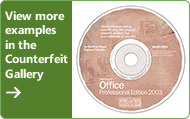When dealing in the realm of security features, where the technology itself is covertly encoded into a graphic file that is eventually printed either as a package, document, banknote, etc., it is important to consider the fine details. Some specs to pay attention to are usually resolution, registration, color process, printing process, applied screens, dot/line structure detail, density, LPI, etc.
In particular, the halftoning process, typically found in most multi-colored printing processes (CMYK, RGB, etc.) lends itself to some creative potential. For example, depending on what the requirements and desired results are of a given security feature, the shape of the screen may play a key role (dots vs. lines, diamonds vs. ellipses). In some cases, different printing processes impliment different types of screens - Gravure press work is usually easy to spot as there is a triangular rosette that forms, unlike dot screens, which form "flowery" cirlcular rosettes. There is also a benefit to creating a unique screen that contains, for example - a company logo, rather than a dot. Probably most importantly, however, is the angle of the screens. It is good practice for each color screen to be 30 degreees apart, as this generally ensures that there won't be any overlapping or morie effects. With more research and mathematical problem solving, there is potential to take the halftoning process to a whole spectrum of new levels.
For some very interesting demonstrations and information on halftoning, screens and morie effects, click the image below.





























